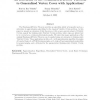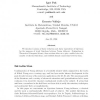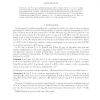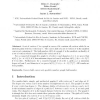SIAMDM
2010
14 years 4 months ago
2010
Abstract. We investigate the degree distribution resulting from graph generation models based on rank-based attachment. In rank-based attachment, all vertices are ranked according ...
SIAMDM
2010
14 years 4 months ago
2010
K¨orner and Malvenuto asked whether one can find n n/2 linear orderings (i.e., permutations) of the first n natural numbers such that any pair of them places two consecutive int...
SIAMDM
2010
14 years 4 months ago
2010
SIAMDM
2010
14 years 4 months ago
2010
Let g1, . . . , gk be tropical polynomials in n variables with Newton polytopes P1, . . . , Pk. We study combinatorial questions on the intersection of the tropical hypersurfaces d...
SIAMDM
2010
14 years 4 months ago
2010
For a fixed graph H, let Ret(H) denote the problem of deciding whether a given input graph is retractable to H. We classify the complexity of Ret(H) when H is a graph (with loops ...
SIAMDM
2010
14 years 4 months ago
2010
We introduce notions of linear reduction and linear equivalence of bijections for the purposes of study bijections between Young tableaux. Originating in Theoretical Computer Scie...
SIAMDM
2010
14 years 4 months ago
2010
Let F be an r-uniform hypergraph with f vertices, where f > r ≥ 3. In [12], R. Yuster posed the problem of whether there exists an algorithm which, for a given r-uniform hyper...
SIAMDM
2010
14 years 4 months ago
2010
A set of vertices C in a graph is convex if it contains all vertices which lie on shortest paths between vertices in C. The convex hull of a set of vertices S is the smallest conve...
SIAMDM
2010
14 years 4 months ago
2010
Given a connected bipartite graph G, we describe a procedure which enumerates and computes all graphs H (if any) for which there is a direct product factorization G ∼= H × K2. W...
SIAMDM
2010
14 years 4 months ago
2010
We consider a variation of a problem stated by Erd˝os and Szekeres in 1935 about the existence of a number fES (k) such that any set S of at least fES (k) points in general posit...





